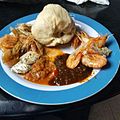| This article possibly contains original research. Please improve it by verifying the claims made and adding inline citations. Statements consisting only of original research should be removed. (June 2011) (Learn how and when to remove this message) |
 Kenkey and ground pepper with sardine Kenkey and ground pepper with sardine | |
| Alternative names | kɔmi pronounced (kormi), |
|---|---|
| Type | Swallow, dumpling |
| Place of origin | Ghana |
| Main ingredients | Ground corn |

Kenkey (also known as kɔmi, otim, kooboo or dorkunu) is a staple swallow food similar to sourdough dumplings from the Ga and Fante-inhabited regions of West Africa, usually served with pepper crudaiola and fried fish, soup or stew.
Description
Kenkey is produced by steeping grains of maize in water for about one week, before they are then milled and kneaded with water into a dough. The dough is allowed to ferment for four days to a week before part of the dough is cooked.
Variations
Areas where kenkey is eaten include Ghana, eastern Côte d'Ivoire, Togo and western Benin. It is usually made from ground corn (maize), like sadza and ugali. It is popularly known as kɔmi (pronounced kormi) by the Gas or dokono by the Akans in Ghana.
In the Caribbean, there are variations of an indigenous dessert of Mesoamerican origin, i.e. sweet tamale, which was adopted by Africans brought to the region during slavery and indentureship. As such, African influence can be found in the names of the variations like: ducana (in Antigua and Barbuda) , duckunoo, duckanoo (also blue drawers or tie-a-leaf in Jamaica) , doukounou (in Haiti), ducunu/ dukunu (also tamalito in Belize), and dokonon (in French Guiana). In Guyana, it is called conkie (pronounced /kankee/). In Trinidad it is called paime (pronounced /pay-me/) , and differs in that it does not contain plantain, but may include coconut, pumpkin and/or raisins. The dish is usually associated with Christmas time. In Latin America, it is made with cornmeal, masa or yuca, while in the Caribbean, it is tyically made with cornmeal, plantain or sweet potato. Maize and sweet potato were staples of the indigenous Amerindians of the Americas, hence Jamaicans and other Antilleans typically add sweet potato and grated green bananas to cornmeal or flour with coconut, sugar, spices and vanilla. The mixture is wrapped in banana leaves, then steamed.

Unlike ugali, making kenkey involves letting the maize ferment before cooking. Therefore, preparation takes a few days in order to let the dough ferment. Corn meal is mixed with cornstarch and water is added until a smooth and consistent dough is obtained. It is covered and left in a warm place for the fermentation to take place. After fermentation, the kenkey is partially cooked, wrapped in banana leaves, corn husks, or foil, and steamed. There are several versions of kenkey, such as Ga and Fante kenkey. The Ga kenkey is more common in most parts of Ghana.
Ice kenkey is a meal made from kenkey mixed with water, sugar, powdered milk, and ice.
Gallery
See also
References
- ^ Atter, Amy; Ofori, Hayford; Anyebuno, George Anabila; Amoo-Gyasi, Michael; Amoa-Awua, Wisdom Kofi (2015). "Safety of a street vended traditional maize beverage, ice-kenkey, in Ghana". Food Control. 55: 200–205. doi:10.1016/j.foodcont.2015.02.043.
- ^ "Ghana: Kenkey". 196 flavors. 2019-06-21. Retrieved 2020-06-04.
- "Trinidad Paime: A Favourite Christmas Treat". SimplyTriniCooking.com. Retrieved 2024-05-19.
- "KENKEY". Ghanaweb. Retrieved 9 August 2013.
External links
- "West Africa Recipe - Cooking Kenkey" Archived 2012-03-06 at the Wayback Machine. West Africa Secondary School, Accra, Ghana. PBS Kids.
- "Questions and Answers > Food products > What is kenkey and how is it made?". Food-info.net. Wageningen University, The Netherlands.
- Fran Osseo-Asare (March 28, 2007). "Ghana-style Kenkey". Betumi.com.
- "Studies on kenkey : a food product made from corn in Ghana"
- Acceleration of the fermentation of kenkey, an indigenous fermented maize food of Ghana.
- Microbiological and Aromatic Characteristics of Fermented Maize Doughs for Kenkey Production in Ghana.
- Nutrient Content and Survival of Selected Pathogenic Bacteria in Kenkey Used as a Weaning Food in Ghana.
| African cuisine | |
|---|---|
| National cuisines |
|
| Ethnic and regional cuisines | |
| Lists | |
| Maize and corn | |||||||||||||||
|---|---|---|---|---|---|---|---|---|---|---|---|---|---|---|---|
| Varieties | |||||||||||||||
| Parts | |||||||||||||||
| Processing | |||||||||||||||
| Pathology | |||||||||||||||
| Production | |||||||||||||||
| Culture |
| ||||||||||||||
| Maize dishes |
| ||||||||||||||
- Nout, M. J. R.; Kok, B.; Vela, E.; Nche, P. F.; Rombouts, F. M. (1995-01-01). "Acceleration of the fermentation of kenkey, an indigenous fermented maize food of Ghana". Food Research International. 28 (6): 599–604. doi:10.1016/0963-9969(95)00059-3. ISSN 0963-9969.
- M, Halm; A, Lillie; Ak, Sørensen; M, Jakobsen (July 1993). "Microbiological and Aromatic Characteristics of Fermented Maize Doughs for Kenkey Production in Ghana". International Journal of Food Microbiology. 19 (2): 135–143. doi:10.1016/0168-1605(93)90179-k. PMID 8398627. Retrieved 2020-06-06.
- A, Annan-Prah; Ja, Agyeman (1997-04-30). "Nutrient Content and Survival of Selected Pathogenic Bacteria in Kenkey Used as a Weaning Food in Ghana". Acta Tropica. 65 (1): 33–42. doi:10.1016/s0001-706x(97)00650-5. PMID 9140512. Retrieved 2020-06-06.


